Information System Innovation and New Technologies Report
VerifiedAdded on 2022/10/12
|10
|2759
|390
Report
AI Summary
This report delves into the dynamic landscape of information system (IS) innovation and new technologies. It begins by defining innovation and its importance in the business world, emphasizing the competitive advantages it offers. The report then explores various current technological trends, including SaaS, cloud computing, AI, and others, and their impact on business processes and consumer experiences. A significant portion of the report focuses on cloud computing, detailing its benefits such as cost savings, enhanced flexibility, and improved data security, as well as emerging trends like hybrid and multi-cloud solutions. The integration of AI with cloud computing and edge computing is also discussed. The report concludes by highlighting the importance of adapting to these changes and the opportunities they create for businesses, professionals, and the evolution of IT infrastructure. The report also emphasizes that all modern technologies are building hand-in-hand and breakthrough in one area stimulates innovation in other shaping the digital world in near future.

Running Head: INFORMATION SYSTEM 0
Innovation and New Technologies
Innovation and New Technologies
Paraphrase This Document
Need a fresh take? Get an instant paraphrase of this document with our AI Paraphraser
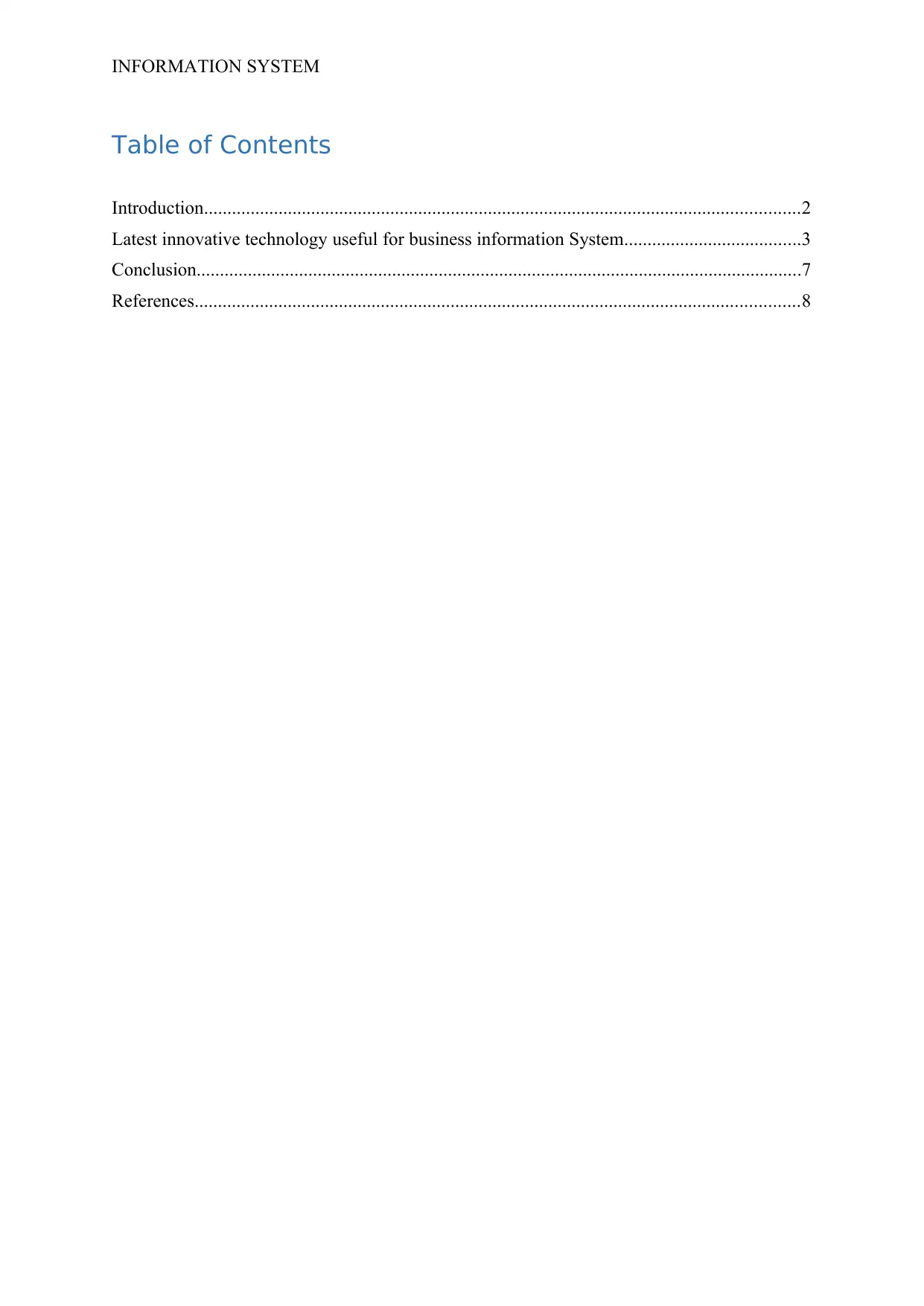
INFORMATION SYSTEM
Table of Contents
Introduction................................................................................................................................2
Latest innovative technology useful for business information System......................................3
Conclusion..................................................................................................................................7
References..................................................................................................................................8
Table of Contents
Introduction................................................................................................................................2
Latest innovative technology useful for business information System......................................3
Conclusion..................................................................................................................................7
References..................................................................................................................................8
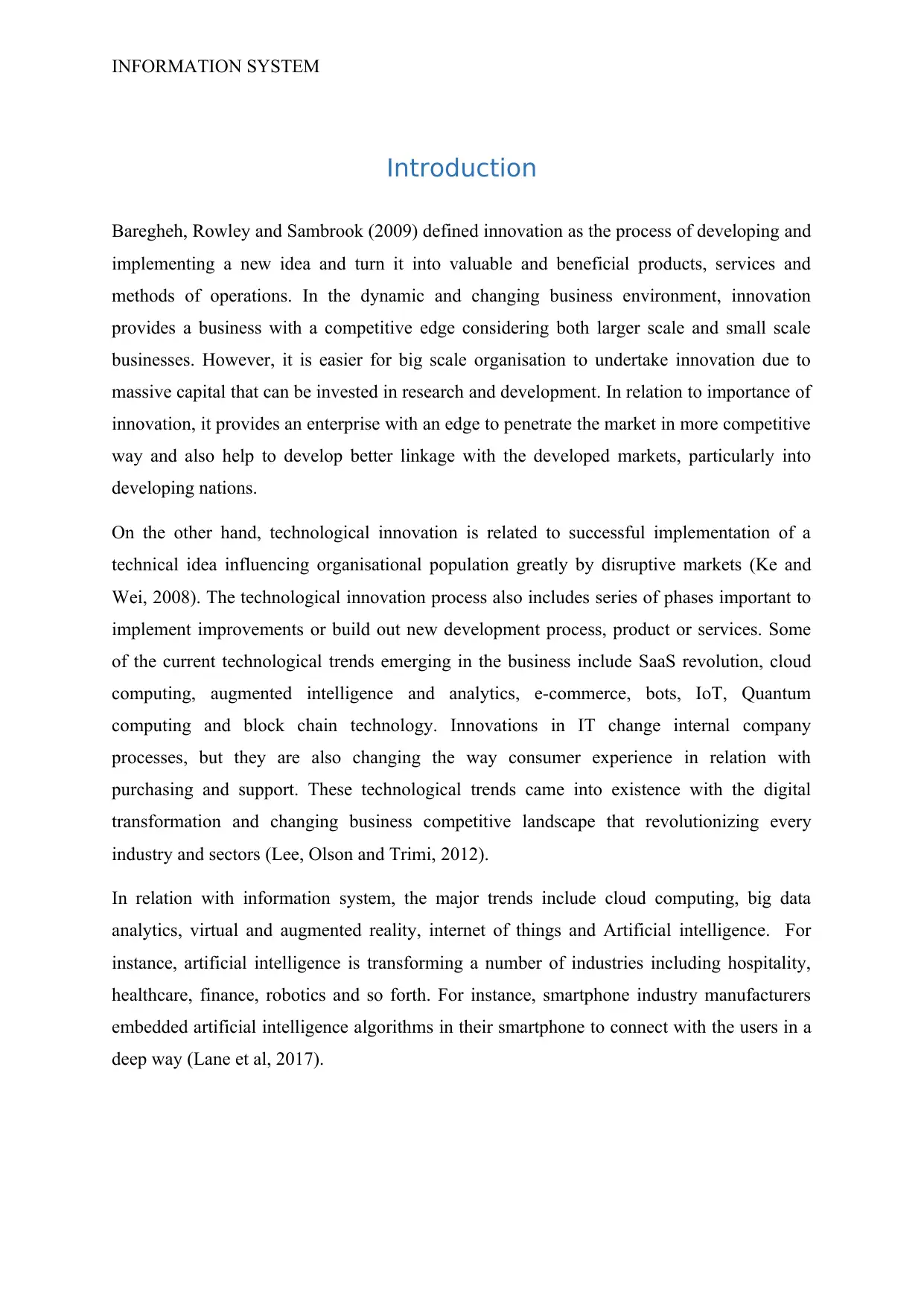
INFORMATION SYSTEM
Introduction
Baregheh, Rowley and Sambrook (2009) defined innovation as the process of developing and
implementing a new idea and turn it into valuable and beneficial products, services and
methods of operations. In the dynamic and changing business environment, innovation
provides a business with a competitive edge considering both larger scale and small scale
businesses. However, it is easier for big scale organisation to undertake innovation due to
massive capital that can be invested in research and development. In relation to importance of
innovation, it provides an enterprise with an edge to penetrate the market in more competitive
way and also help to develop better linkage with the developed markets, particularly into
developing nations.
On the other hand, technological innovation is related to successful implementation of a
technical idea influencing organisational population greatly by disruptive markets (Ke and
Wei, 2008). The technological innovation process also includes series of phases important to
implement improvements or build out new development process, product or services. Some
of the current technological trends emerging in the business include SaaS revolution, cloud
computing, augmented intelligence and analytics, e-commerce, bots, IoT, Quantum
computing and block chain technology. Innovations in IT change internal company
processes, but they are also changing the way consumer experience in relation with
purchasing and support. These technological trends came into existence with the digital
transformation and changing business competitive landscape that revolutionizing every
industry and sectors (Lee, Olson and Trimi, 2012).
In relation with information system, the major trends include cloud computing, big data
analytics, virtual and augmented reality, internet of things and Artificial intelligence. For
instance, artificial intelligence is transforming a number of industries including hospitality,
healthcare, finance, robotics and so forth. For instance, smartphone industry manufacturers
embedded artificial intelligence algorithms in their smartphone to connect with the users in a
deep way (Lane et al, 2017).
Introduction
Baregheh, Rowley and Sambrook (2009) defined innovation as the process of developing and
implementing a new idea and turn it into valuable and beneficial products, services and
methods of operations. In the dynamic and changing business environment, innovation
provides a business with a competitive edge considering both larger scale and small scale
businesses. However, it is easier for big scale organisation to undertake innovation due to
massive capital that can be invested in research and development. In relation to importance of
innovation, it provides an enterprise with an edge to penetrate the market in more competitive
way and also help to develop better linkage with the developed markets, particularly into
developing nations.
On the other hand, technological innovation is related to successful implementation of a
technical idea influencing organisational population greatly by disruptive markets (Ke and
Wei, 2008). The technological innovation process also includes series of phases important to
implement improvements or build out new development process, product or services. Some
of the current technological trends emerging in the business include SaaS revolution, cloud
computing, augmented intelligence and analytics, e-commerce, bots, IoT, Quantum
computing and block chain technology. Innovations in IT change internal company
processes, but they are also changing the way consumer experience in relation with
purchasing and support. These technological trends came into existence with the digital
transformation and changing business competitive landscape that revolutionizing every
industry and sectors (Lee, Olson and Trimi, 2012).
In relation with information system, the major trends include cloud computing, big data
analytics, virtual and augmented reality, internet of things and Artificial intelligence. For
instance, artificial intelligence is transforming a number of industries including hospitality,
healthcare, finance, robotics and so forth. For instance, smartphone industry manufacturers
embedded artificial intelligence algorithms in their smartphone to connect with the users in a
deep way (Lane et al, 2017).
⊘ This is a preview!⊘
Do you want full access?
Subscribe today to unlock all pages.

Trusted by 1+ million students worldwide
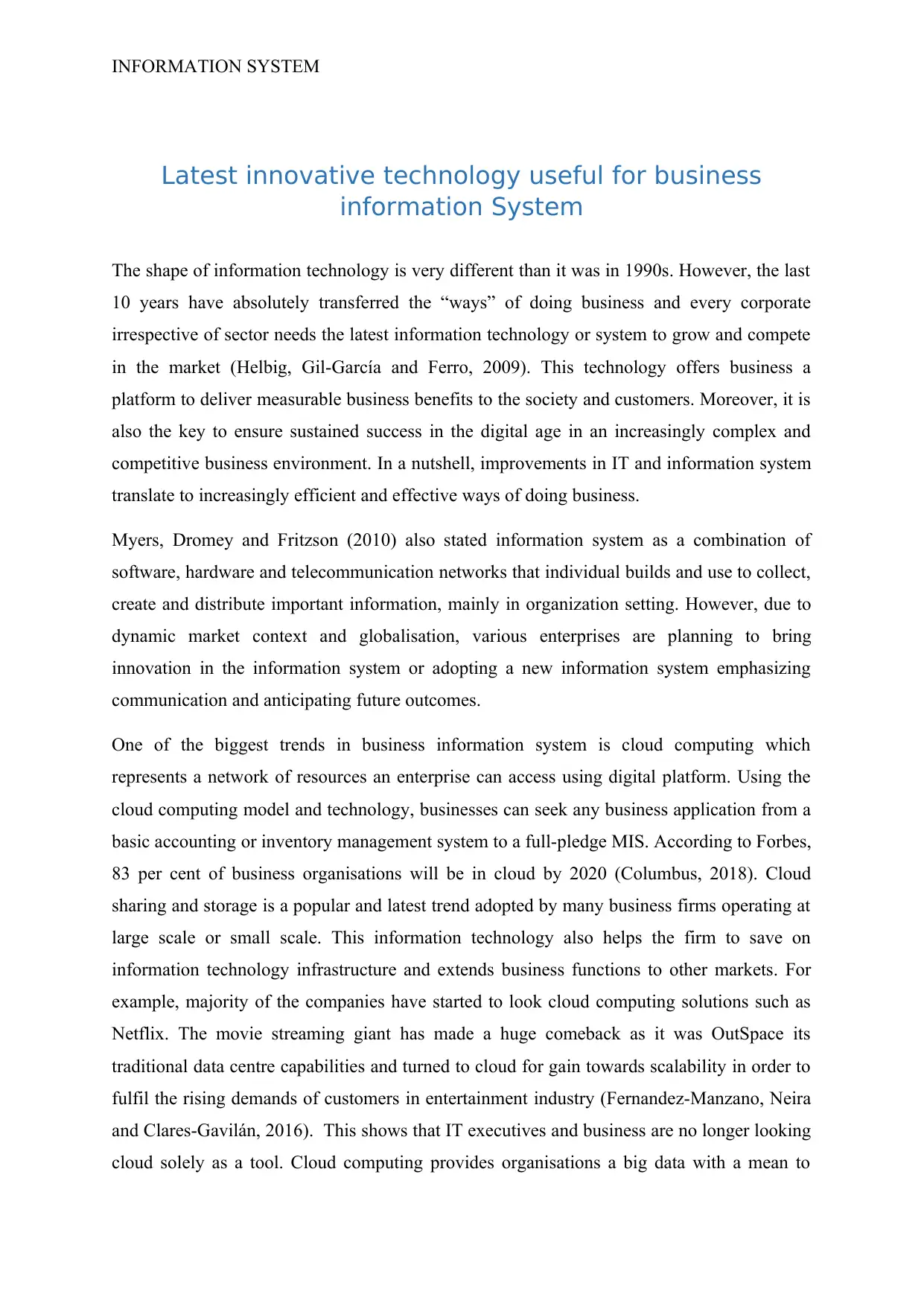
INFORMATION SYSTEM
Latest innovative technology useful for business
information System
The shape of information technology is very different than it was in 1990s. However, the last
10 years have absolutely transferred the “ways” of doing business and every corporate
irrespective of sector needs the latest information technology or system to grow and compete
in the market (Helbig, Gil-García and Ferro, 2009). This technology offers business a
platform to deliver measurable business benefits to the society and customers. Moreover, it is
also the key to ensure sustained success in the digital age in an increasingly complex and
competitive business environment. In a nutshell, improvements in IT and information system
translate to increasingly efficient and effective ways of doing business.
Myers, Dromey and Fritzson (2010) also stated information system as a combination of
software, hardware and telecommunication networks that individual builds and use to collect,
create and distribute important information, mainly in organization setting. However, due to
dynamic market context and globalisation, various enterprises are planning to bring
innovation in the information system or adopting a new information system emphasizing
communication and anticipating future outcomes.
One of the biggest trends in business information system is cloud computing which
represents a network of resources an enterprise can access using digital platform. Using the
cloud computing model and technology, businesses can seek any business application from a
basic accounting or inventory management system to a full-pledge MIS. According to Forbes,
83 per cent of business organisations will be in cloud by 2020 (Columbus, 2018). Cloud
sharing and storage is a popular and latest trend adopted by many business firms operating at
large scale or small scale. This information technology also helps the firm to save on
information technology infrastructure and extends business functions to other markets. For
example, majority of the companies have started to look cloud computing solutions such as
Netflix. The movie streaming giant has made a huge comeback as it was OutSpace its
traditional data centre capabilities and turned to cloud for gain towards scalability in order to
fulfil the rising demands of customers in entertainment industry (Fernandez-Manzano, Neira
and Clares-Gavilán, 2016). This shows that IT executives and business are no longer looking
cloud solely as a tool. Cloud computing provides organisations a big data with a mean to
Latest innovative technology useful for business
information System
The shape of information technology is very different than it was in 1990s. However, the last
10 years have absolutely transferred the “ways” of doing business and every corporate
irrespective of sector needs the latest information technology or system to grow and compete
in the market (Helbig, Gil-García and Ferro, 2009). This technology offers business a
platform to deliver measurable business benefits to the society and customers. Moreover, it is
also the key to ensure sustained success in the digital age in an increasingly complex and
competitive business environment. In a nutshell, improvements in IT and information system
translate to increasingly efficient and effective ways of doing business.
Myers, Dromey and Fritzson (2010) also stated information system as a combination of
software, hardware and telecommunication networks that individual builds and use to collect,
create and distribute important information, mainly in organization setting. However, due to
dynamic market context and globalisation, various enterprises are planning to bring
innovation in the information system or adopting a new information system emphasizing
communication and anticipating future outcomes.
One of the biggest trends in business information system is cloud computing which
represents a network of resources an enterprise can access using digital platform. Using the
cloud computing model and technology, businesses can seek any business application from a
basic accounting or inventory management system to a full-pledge MIS. According to Forbes,
83 per cent of business organisations will be in cloud by 2020 (Columbus, 2018). Cloud
sharing and storage is a popular and latest trend adopted by many business firms operating at
large scale or small scale. This information technology also helps the firm to save on
information technology infrastructure and extends business functions to other markets. For
example, majority of the companies have started to look cloud computing solutions such as
Netflix. The movie streaming giant has made a huge comeback as it was OutSpace its
traditional data centre capabilities and turned to cloud for gain towards scalability in order to
fulfil the rising demands of customers in entertainment industry (Fernandez-Manzano, Neira
and Clares-Gavilán, 2016). This shows that IT executives and business are no longer looking
cloud solely as a tool. Cloud computing provides organisations a big data with a mean to
Paraphrase This Document
Need a fresh take? Get an instant paraphrase of this document with our AI Paraphraser
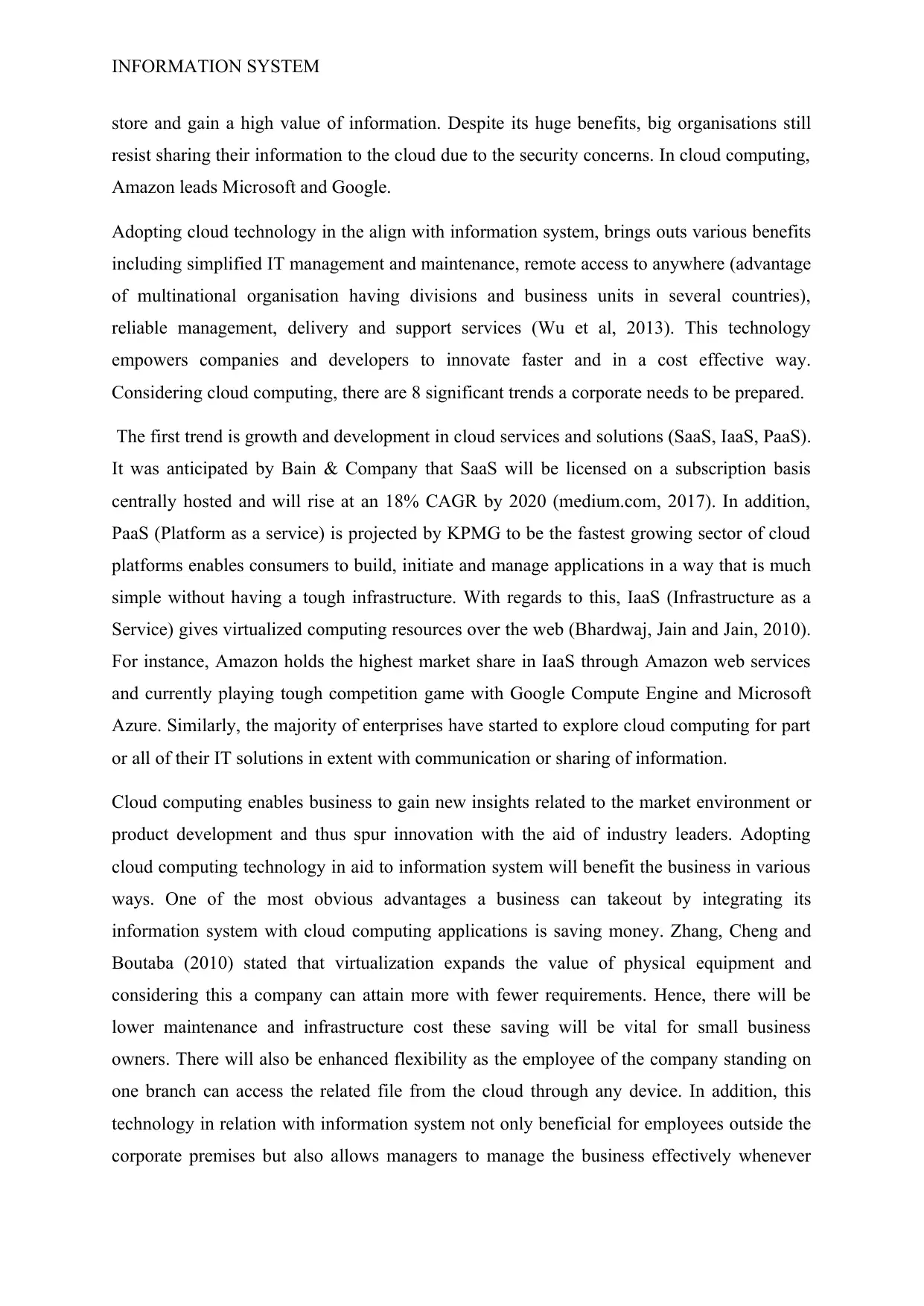
INFORMATION SYSTEM
store and gain a high value of information. Despite its huge benefits, big organisations still
resist sharing their information to the cloud due to the security concerns. In cloud computing,
Amazon leads Microsoft and Google.
Adopting cloud technology in the align with information system, brings outs various benefits
including simplified IT management and maintenance, remote access to anywhere (advantage
of multinational organisation having divisions and business units in several countries),
reliable management, delivery and support services (Wu et al, 2013). This technology
empowers companies and developers to innovate faster and in a cost effective way.
Considering cloud computing, there are 8 significant trends a corporate needs to be prepared.
The first trend is growth and development in cloud services and solutions (SaaS, IaaS, PaaS).
It was anticipated by Bain & Company that SaaS will be licensed on a subscription basis
centrally hosted and will rise at an 18% CAGR by 2020 (medium.com, 2017). In addition,
PaaS (Platform as a service) is projected by KPMG to be the fastest growing sector of cloud
platforms enables consumers to build, initiate and manage applications in a way that is much
simple without having a tough infrastructure. With regards to this, IaaS (Infrastructure as a
Service) gives virtualized computing resources over the web (Bhardwaj, Jain and Jain, 2010).
For instance, Amazon holds the highest market share in IaaS through Amazon web services
and currently playing tough competition game with Google Compute Engine and Microsoft
Azure. Similarly, the majority of enterprises have started to explore cloud computing for part
or all of their IT solutions in extent with communication or sharing of information.
Cloud computing enables business to gain new insights related to the market environment or
product development and thus spur innovation with the aid of industry leaders. Adopting
cloud computing technology in aid to information system will benefit the business in various
ways. One of the most obvious advantages a business can takeout by integrating its
information system with cloud computing applications is saving money. Zhang, Cheng and
Boutaba (2010) stated that virtualization expands the value of physical equipment and
considering this a company can attain more with fewer requirements. Hence, there will be
lower maintenance and infrastructure cost these saving will be vital for small business
owners. There will also be enhanced flexibility as the employee of the company standing on
one branch can access the related file from the cloud through any device. In addition, this
technology in relation with information system not only beneficial for employees outside the
corporate premises but also allows managers to manage the business effectively whenever
store and gain a high value of information. Despite its huge benefits, big organisations still
resist sharing their information to the cloud due to the security concerns. In cloud computing,
Amazon leads Microsoft and Google.
Adopting cloud technology in the align with information system, brings outs various benefits
including simplified IT management and maintenance, remote access to anywhere (advantage
of multinational organisation having divisions and business units in several countries),
reliable management, delivery and support services (Wu et al, 2013). This technology
empowers companies and developers to innovate faster and in a cost effective way.
Considering cloud computing, there are 8 significant trends a corporate needs to be prepared.
The first trend is growth and development in cloud services and solutions (SaaS, IaaS, PaaS).
It was anticipated by Bain & Company that SaaS will be licensed on a subscription basis
centrally hosted and will rise at an 18% CAGR by 2020 (medium.com, 2017). In addition,
PaaS (Platform as a service) is projected by KPMG to be the fastest growing sector of cloud
platforms enables consumers to build, initiate and manage applications in a way that is much
simple without having a tough infrastructure. With regards to this, IaaS (Infrastructure as a
Service) gives virtualized computing resources over the web (Bhardwaj, Jain and Jain, 2010).
For instance, Amazon holds the highest market share in IaaS through Amazon web services
and currently playing tough competition game with Google Compute Engine and Microsoft
Azure. Similarly, the majority of enterprises have started to explore cloud computing for part
or all of their IT solutions in extent with communication or sharing of information.
Cloud computing enables business to gain new insights related to the market environment or
product development and thus spur innovation with the aid of industry leaders. Adopting
cloud computing technology in aid to information system will benefit the business in various
ways. One of the most obvious advantages a business can takeout by integrating its
information system with cloud computing applications is saving money. Zhang, Cheng and
Boutaba (2010) stated that virtualization expands the value of physical equipment and
considering this a company can attain more with fewer requirements. Hence, there will be
lower maintenance and infrastructure cost these saving will be vital for small business
owners. There will also be enhanced flexibility as the employee of the company standing on
one branch can access the related file from the cloud through any device. In addition, this
technology in relation with information system not only beneficial for employees outside the
corporate premises but also allows managers to manage the business effectively whenever
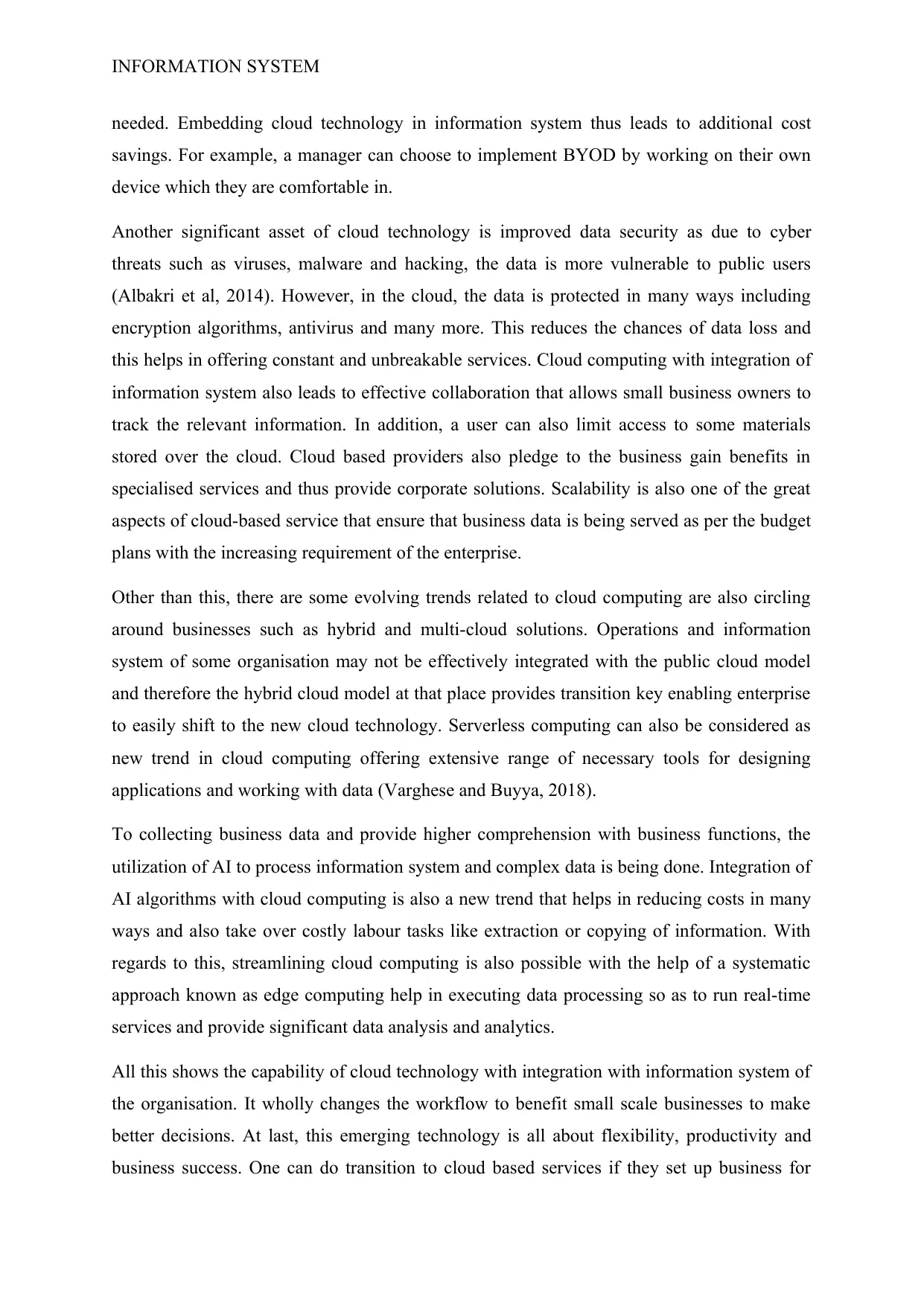
INFORMATION SYSTEM
needed. Embedding cloud technology in information system thus leads to additional cost
savings. For example, a manager can choose to implement BYOD by working on their own
device which they are comfortable in.
Another significant asset of cloud technology is improved data security as due to cyber
threats such as viruses, malware and hacking, the data is more vulnerable to public users
(Albakri et al, 2014). However, in the cloud, the data is protected in many ways including
encryption algorithms, antivirus and many more. This reduces the chances of data loss and
this helps in offering constant and unbreakable services. Cloud computing with integration of
information system also leads to effective collaboration that allows small business owners to
track the relevant information. In addition, a user can also limit access to some materials
stored over the cloud. Cloud based providers also pledge to the business gain benefits in
specialised services and thus provide corporate solutions. Scalability is also one of the great
aspects of cloud-based service that ensure that business data is being served as per the budget
plans with the increasing requirement of the enterprise.
Other than this, there are some evolving trends related to cloud computing are also circling
around businesses such as hybrid and multi-cloud solutions. Operations and information
system of some organisation may not be effectively integrated with the public cloud model
and therefore the hybrid cloud model at that place provides transition key enabling enterprise
to easily shift to the new cloud technology. Serverless computing can also be considered as
new trend in cloud computing offering extensive range of necessary tools for designing
applications and working with data (Varghese and Buyya, 2018).
To collecting business data and provide higher comprehension with business functions, the
utilization of AI to process information system and complex data is being done. Integration of
AI algorithms with cloud computing is also a new trend that helps in reducing costs in many
ways and also take over costly labour tasks like extraction or copying of information. With
regards to this, streamlining cloud computing is also possible with the help of a systematic
approach known as edge computing help in executing data processing so as to run real-time
services and provide significant data analysis and analytics.
All this shows the capability of cloud technology with integration with information system of
the organisation. It wholly changes the workflow to benefit small scale businesses to make
better decisions. At last, this emerging technology is all about flexibility, productivity and
business success. One can do transition to cloud based services if they set up business for
needed. Embedding cloud technology in information system thus leads to additional cost
savings. For example, a manager can choose to implement BYOD by working on their own
device which they are comfortable in.
Another significant asset of cloud technology is improved data security as due to cyber
threats such as viruses, malware and hacking, the data is more vulnerable to public users
(Albakri et al, 2014). However, in the cloud, the data is protected in many ways including
encryption algorithms, antivirus and many more. This reduces the chances of data loss and
this helps in offering constant and unbreakable services. Cloud computing with integration of
information system also leads to effective collaboration that allows small business owners to
track the relevant information. In addition, a user can also limit access to some materials
stored over the cloud. Cloud based providers also pledge to the business gain benefits in
specialised services and thus provide corporate solutions. Scalability is also one of the great
aspects of cloud-based service that ensure that business data is being served as per the budget
plans with the increasing requirement of the enterprise.
Other than this, there are some evolving trends related to cloud computing are also circling
around businesses such as hybrid and multi-cloud solutions. Operations and information
system of some organisation may not be effectively integrated with the public cloud model
and therefore the hybrid cloud model at that place provides transition key enabling enterprise
to easily shift to the new cloud technology. Serverless computing can also be considered as
new trend in cloud computing offering extensive range of necessary tools for designing
applications and working with data (Varghese and Buyya, 2018).
To collecting business data and provide higher comprehension with business functions, the
utilization of AI to process information system and complex data is being done. Integration of
AI algorithms with cloud computing is also a new trend that helps in reducing costs in many
ways and also take over costly labour tasks like extraction or copying of information. With
regards to this, streamlining cloud computing is also possible with the help of a systematic
approach known as edge computing help in executing data processing so as to run real-time
services and provide significant data analysis and analytics.
All this shows the capability of cloud technology with integration with information system of
the organisation. It wholly changes the workflow to benefit small scale businesses to make
better decisions. At last, this emerging technology is all about flexibility, productivity and
business success. One can do transition to cloud based services if they set up business for
⊘ This is a preview!⊘
Do you want full access?
Subscribe today to unlock all pages.

Trusted by 1+ million students worldwide
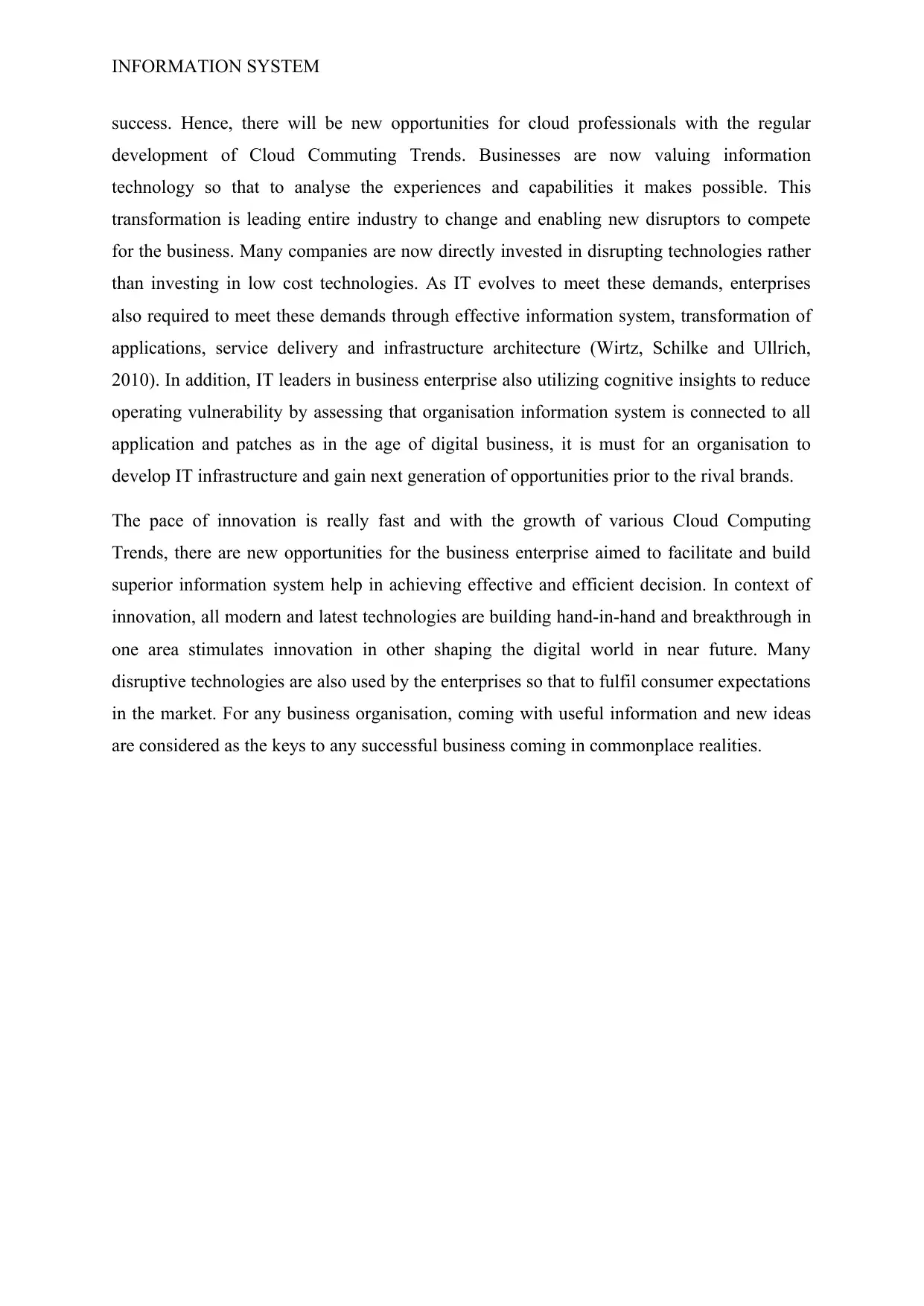
INFORMATION SYSTEM
success. Hence, there will be new opportunities for cloud professionals with the regular
development of Cloud Commuting Trends. Businesses are now valuing information
technology so that to analyse the experiences and capabilities it makes possible. This
transformation is leading entire industry to change and enabling new disruptors to compete
for the business. Many companies are now directly invested in disrupting technologies rather
than investing in low cost technologies. As IT evolves to meet these demands, enterprises
also required to meet these demands through effective information system, transformation of
applications, service delivery and infrastructure architecture (Wirtz, Schilke and Ullrich,
2010). In addition, IT leaders in business enterprise also utilizing cognitive insights to reduce
operating vulnerability by assessing that organisation information system is connected to all
application and patches as in the age of digital business, it is must for an organisation to
develop IT infrastructure and gain next generation of opportunities prior to the rival brands.
The pace of innovation is really fast and with the growth of various Cloud Computing
Trends, there are new opportunities for the business enterprise aimed to facilitate and build
superior information system help in achieving effective and efficient decision. In context of
innovation, all modern and latest technologies are building hand-in-hand and breakthrough in
one area stimulates innovation in other shaping the digital world in near future. Many
disruptive technologies are also used by the enterprises so that to fulfil consumer expectations
in the market. For any business organisation, coming with useful information and new ideas
are considered as the keys to any successful business coming in commonplace realities.
success. Hence, there will be new opportunities for cloud professionals with the regular
development of Cloud Commuting Trends. Businesses are now valuing information
technology so that to analyse the experiences and capabilities it makes possible. This
transformation is leading entire industry to change and enabling new disruptors to compete
for the business. Many companies are now directly invested in disrupting technologies rather
than investing in low cost technologies. As IT evolves to meet these demands, enterprises
also required to meet these demands through effective information system, transformation of
applications, service delivery and infrastructure architecture (Wirtz, Schilke and Ullrich,
2010). In addition, IT leaders in business enterprise also utilizing cognitive insights to reduce
operating vulnerability by assessing that organisation information system is connected to all
application and patches as in the age of digital business, it is must for an organisation to
develop IT infrastructure and gain next generation of opportunities prior to the rival brands.
The pace of innovation is really fast and with the growth of various Cloud Computing
Trends, there are new opportunities for the business enterprise aimed to facilitate and build
superior information system help in achieving effective and efficient decision. In context of
innovation, all modern and latest technologies are building hand-in-hand and breakthrough in
one area stimulates innovation in other shaping the digital world in near future. Many
disruptive technologies are also used by the enterprises so that to fulfil consumer expectations
in the market. For any business organisation, coming with useful information and new ideas
are considered as the keys to any successful business coming in commonplace realities.
Paraphrase This Document
Need a fresh take? Get an instant paraphrase of this document with our AI Paraphraser
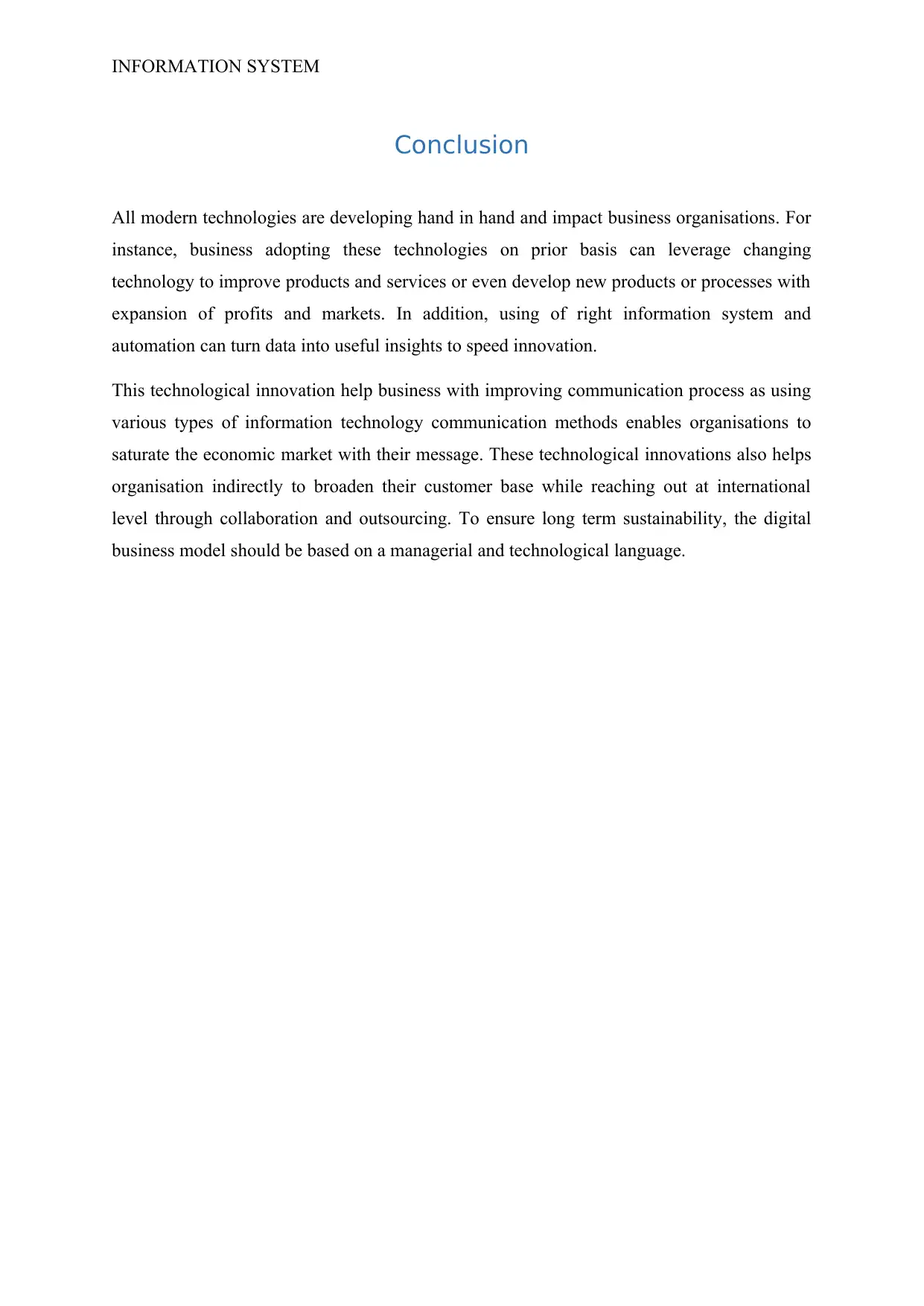
INFORMATION SYSTEM
Conclusion
All modern technologies are developing hand in hand and impact business organisations. For
instance, business adopting these technologies on prior basis can leverage changing
technology to improve products and services or even develop new products or processes with
expansion of profits and markets. In addition, using of right information system and
automation can turn data into useful insights to speed innovation.
This technological innovation help business with improving communication process as using
various types of information technology communication methods enables organisations to
saturate the economic market with their message. These technological innovations also helps
organisation indirectly to broaden their customer base while reaching out at international
level through collaboration and outsourcing. To ensure long term sustainability, the digital
business model should be based on a managerial and technological language.
Conclusion
All modern technologies are developing hand in hand and impact business organisations. For
instance, business adopting these technologies on prior basis can leverage changing
technology to improve products and services or even develop new products or processes with
expansion of profits and markets. In addition, using of right information system and
automation can turn data into useful insights to speed innovation.
This technological innovation help business with improving communication process as using
various types of information technology communication methods enables organisations to
saturate the economic market with their message. These technological innovations also helps
organisation indirectly to broaden their customer base while reaching out at international
level through collaboration and outsourcing. To ensure long term sustainability, the digital
business model should be based on a managerial and technological language.
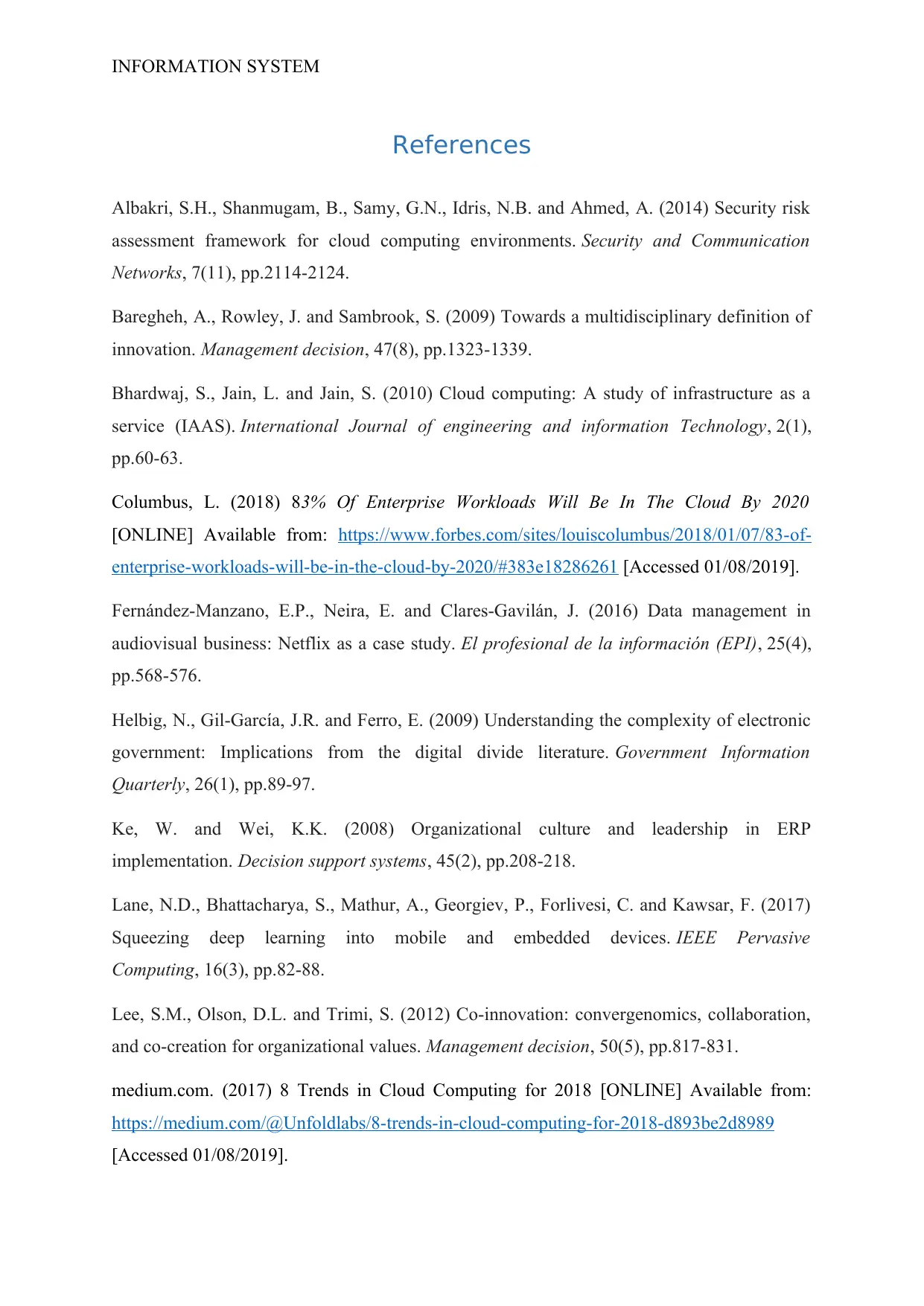
INFORMATION SYSTEM
References
Albakri, S.H., Shanmugam, B., Samy, G.N., Idris, N.B. and Ahmed, A. (2014) Security risk
assessment framework for cloud computing environments. Security and Communication
Networks, 7(11), pp.2114-2124.
Baregheh, A., Rowley, J. and Sambrook, S. (2009) Towards a multidisciplinary definition of
innovation. Management decision, 47(8), pp.1323-1339.
Bhardwaj, S., Jain, L. and Jain, S. (2010) Cloud computing: A study of infrastructure as a
service (IAAS). International Journal of engineering and information Technology, 2(1),
pp.60-63.
Columbus, L. (2018) 83% Of Enterprise Workloads Will Be In The Cloud By 2020
[ONLINE] Available from: https://www.forbes.com/sites/louiscolumbus/2018/01/07/83-of-
enterprise-workloads-will-be-in-the-cloud-by-2020/#383e18286261 [Accessed 01/08/2019].
Fernández-Manzano, E.P., Neira, E. and Clares-Gavilán, J. (2016) Data management in
audiovisual business: Netflix as a case study. El profesional de la información (EPI), 25(4),
pp.568-576.
Helbig, N., Gil-García, J.R. and Ferro, E. (2009) Understanding the complexity of electronic
government: Implications from the digital divide literature. Government Information
Quarterly, 26(1), pp.89-97.
Ke, W. and Wei, K.K. (2008) Organizational culture and leadership in ERP
implementation. Decision support systems, 45(2), pp.208-218.
Lane, N.D., Bhattacharya, S., Mathur, A., Georgiev, P., Forlivesi, C. and Kawsar, F. (2017)
Squeezing deep learning into mobile and embedded devices. IEEE Pervasive
Computing, 16(3), pp.82-88.
Lee, S.M., Olson, D.L. and Trimi, S. (2012) Co-innovation: convergenomics, collaboration,
and co-creation for organizational values. Management decision, 50(5), pp.817-831.
medium.com. (2017) 8 Trends in Cloud Computing for 2018 [ONLINE] Available from:
https://medium.com/@Unfoldlabs/8-trends-in-cloud-computing-for-2018-d893be2d8989
[Accessed 01/08/2019].
References
Albakri, S.H., Shanmugam, B., Samy, G.N., Idris, N.B. and Ahmed, A. (2014) Security risk
assessment framework for cloud computing environments. Security and Communication
Networks, 7(11), pp.2114-2124.
Baregheh, A., Rowley, J. and Sambrook, S. (2009) Towards a multidisciplinary definition of
innovation. Management decision, 47(8), pp.1323-1339.
Bhardwaj, S., Jain, L. and Jain, S. (2010) Cloud computing: A study of infrastructure as a
service (IAAS). International Journal of engineering and information Technology, 2(1),
pp.60-63.
Columbus, L. (2018) 83% Of Enterprise Workloads Will Be In The Cloud By 2020
[ONLINE] Available from: https://www.forbes.com/sites/louiscolumbus/2018/01/07/83-of-
enterprise-workloads-will-be-in-the-cloud-by-2020/#383e18286261 [Accessed 01/08/2019].
Fernández-Manzano, E.P., Neira, E. and Clares-Gavilán, J. (2016) Data management in
audiovisual business: Netflix as a case study. El profesional de la información (EPI), 25(4),
pp.568-576.
Helbig, N., Gil-García, J.R. and Ferro, E. (2009) Understanding the complexity of electronic
government: Implications from the digital divide literature. Government Information
Quarterly, 26(1), pp.89-97.
Ke, W. and Wei, K.K. (2008) Organizational culture and leadership in ERP
implementation. Decision support systems, 45(2), pp.208-218.
Lane, N.D., Bhattacharya, S., Mathur, A., Georgiev, P., Forlivesi, C. and Kawsar, F. (2017)
Squeezing deep learning into mobile and embedded devices. IEEE Pervasive
Computing, 16(3), pp.82-88.
Lee, S.M., Olson, D.L. and Trimi, S. (2012) Co-innovation: convergenomics, collaboration,
and co-creation for organizational values. Management decision, 50(5), pp.817-831.
medium.com. (2017) 8 Trends in Cloud Computing for 2018 [ONLINE] Available from:
https://medium.com/@Unfoldlabs/8-trends-in-cloud-computing-for-2018-d893be2d8989
[Accessed 01/08/2019].
⊘ This is a preview!⊘
Do you want full access?
Subscribe today to unlock all pages.

Trusted by 1+ million students worldwide
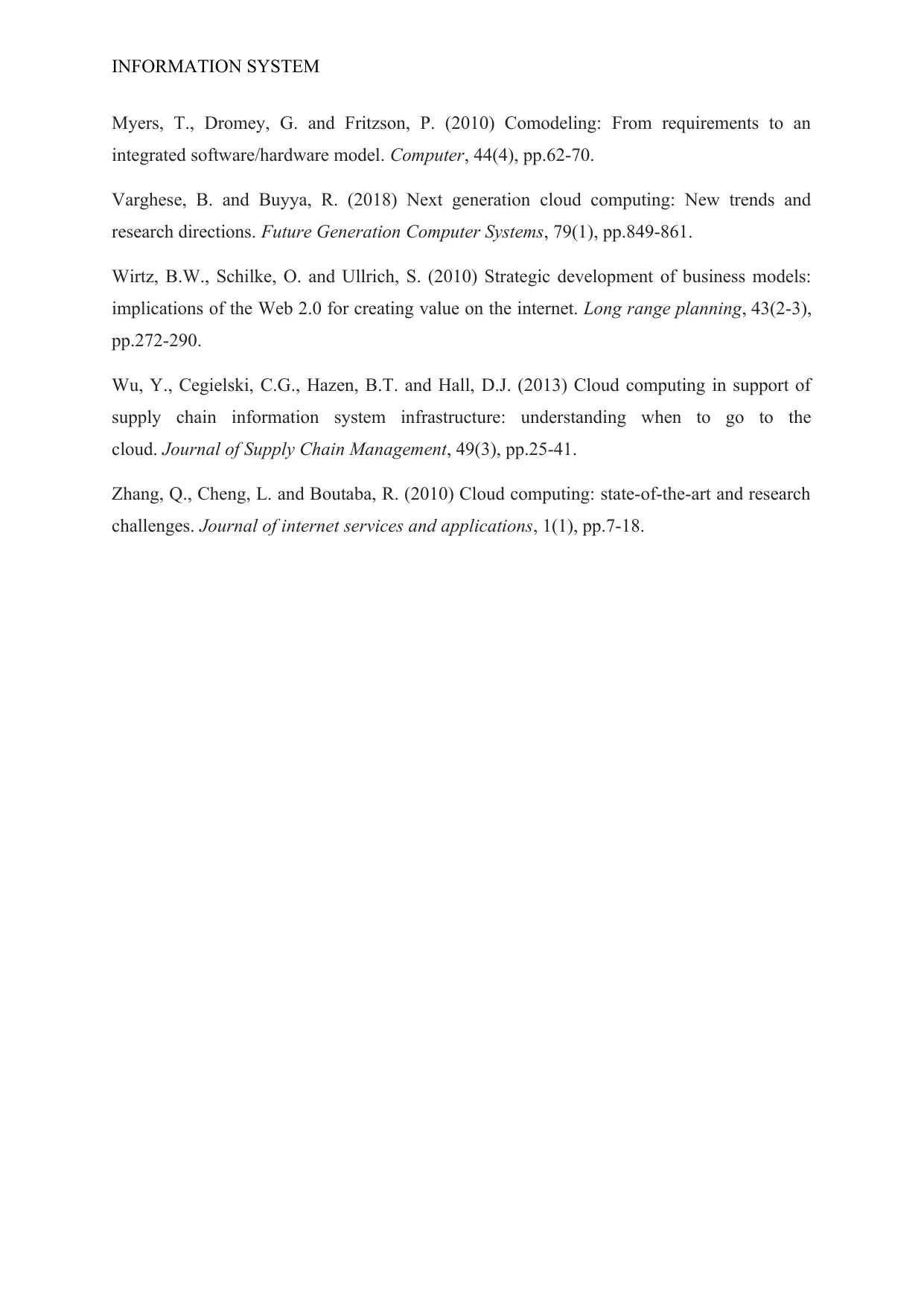
INFORMATION SYSTEM
Myers, T., Dromey, G. and Fritzson, P. (2010) Comodeling: From requirements to an
integrated software/hardware model. Computer, 44(4), pp.62-70.
Varghese, B. and Buyya, R. (2018) Next generation cloud computing: New trends and
research directions. Future Generation Computer Systems, 79(1), pp.849-861.
Wirtz, B.W., Schilke, O. and Ullrich, S. (2010) Strategic development of business models:
implications of the Web 2.0 for creating value on the internet. Long range planning, 43(2-3),
pp.272-290.
Wu, Y., Cegielski, C.G., Hazen, B.T. and Hall, D.J. (2013) Cloud computing in support of
supply chain information system infrastructure: understanding when to go to the
cloud. Journal of Supply Chain Management, 49(3), pp.25-41.
Zhang, Q., Cheng, L. and Boutaba, R. (2010) Cloud computing: state-of-the-art and research
challenges. Journal of internet services and applications, 1(1), pp.7-18.
Myers, T., Dromey, G. and Fritzson, P. (2010) Comodeling: From requirements to an
integrated software/hardware model. Computer, 44(4), pp.62-70.
Varghese, B. and Buyya, R. (2018) Next generation cloud computing: New trends and
research directions. Future Generation Computer Systems, 79(1), pp.849-861.
Wirtz, B.W., Schilke, O. and Ullrich, S. (2010) Strategic development of business models:
implications of the Web 2.0 for creating value on the internet. Long range planning, 43(2-3),
pp.272-290.
Wu, Y., Cegielski, C.G., Hazen, B.T. and Hall, D.J. (2013) Cloud computing in support of
supply chain information system infrastructure: understanding when to go to the
cloud. Journal of Supply Chain Management, 49(3), pp.25-41.
Zhang, Q., Cheng, L. and Boutaba, R. (2010) Cloud computing: state-of-the-art and research
challenges. Journal of internet services and applications, 1(1), pp.7-18.
1 out of 10
Related Documents
Your All-in-One AI-Powered Toolkit for Academic Success.
+13062052269
info@desklib.com
Available 24*7 on WhatsApp / Email
![[object Object]](/_next/static/media/star-bottom.7253800d.svg)
Unlock your academic potential
Copyright © 2020–2025 A2Z Services. All Rights Reserved. Developed and managed by ZUCOL.





